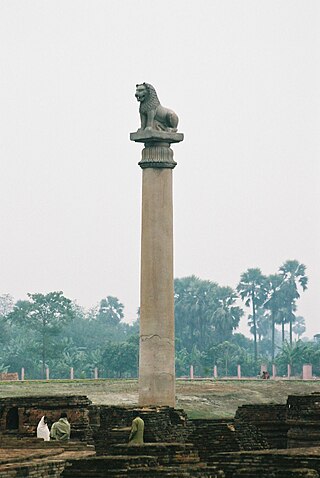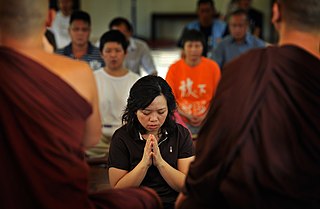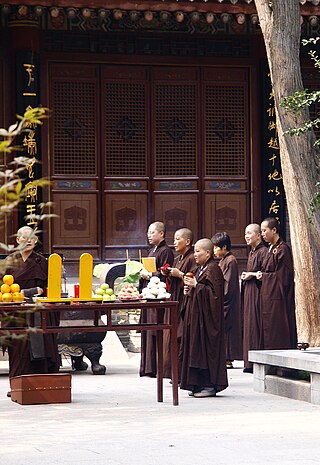Theravāda is the most commonly accepted name of Buddhism's oldest existing school. The school's adherents, termed Theravādins, have preserved their version of Gautama Buddha's teaching or dhamma in the Pāli Canon for over two millennia.
The Vinaya texts are texts of the Buddhist canon (Tripitaka) that also contain the rules and precepts for fully ordained monks and nuns of Buddhist Sanghas. The precepts were initially developed thirteen years after the Buddha's enlightenment. Three parallel Vinaya school traditions remain in use by modern ordained sanghas: the Theravada, Mulasarvastivada and Dharmaguptaka. In addition to these three Vinaya traditions, five other Vinaya schools of Indian Buddhism are preserved in Asian canonical manuscripts, including those of the Kāśyapīya, the Mahāsāṃghika, the Mahīśāsaka, the Sammatīya, and the Sarvāstivāda.

A bhikkhu is an ordained male in Buddhist monasticism. Male and female monastics are members of the Sangha.

The schools of Buddhism are the various institutional and doctrinal divisions of Buddhism which are the teachings off buddhist texts. The schools of Buddhism have existed from ancient times up to the present. The classification and nature of various doctrinal, philosophical or cultural facets of the schools of Buddhism is vague and has been interpreted in many different ways, often due to the sheer number of different sects, subsects, movements, etc. that have made up or currently make up the whole of Buddhist traditions. The sectarian and conceptual divisions of Buddhist thought are part of the modern framework of Buddhist studies, as well as comparative religion in Asia. Some factors in Buddhism appear to be consistent, such as the afterlife. Which differs on the version of Buddhism.

In Buddhism, refuge or taking refuge refers to a religious practice which often includes a prayer or recitation performed at the beginning of the day or of a practice session. Its object is typically the Three Jewels, which are the Buddha, the Dharma, and the Sangha. Taking refuge is a form of aspiration to lead a life with the Triple Gem at its core. In early Buddhist scriptures, taking refuge is an expression of determination to follow the Buddha's path, but not a relinquishing of responsibility. Refuge is common to all major schools of Buddhism.
Śrāvaka (Sanskrit) or Sāvaka (Pali) means "hearer" or, more generally, "disciple". This term is used in Buddhism and Jainism. In Jainism, a śrāvaka is any lay Jain so the term śrāvaka has been used for the Jain community itself. Śrāvakācāras are the lay conduct outlined within the treaties by Śvetāmbara or Digambara mendicants. "In parallel to the prescriptive texts, Jain religious teachers have written a number of stories to illustrate vows in practice and produced a rich répertoire of characters.".

Upāsaka (masculine) or Upāsikā (feminine) are from the Sanskrit and Pāli words for "attendant". This is the title of followers of Buddhism who are not monks, nuns, or novice monastics in a Buddhist order, and who undertake certain vows. In modern times they have a connotation of dedicated piety that is best suggested by terms such as "lay devotee" or "devout lay follower".

Buddhism, specifically Theravāda Buddhism, is the official and state religion of Myanmar since 1961, and practiced by nearly 90% of the population. It is the most religious Buddhist country in terms of the proportion of monks in the population and proportion of income spent on religion. Adherents are most likely found among the dominant Bamar people, Shan, Rakhine, Mon, Karen, and Chinese who are well integrated into Burmese society. Monks, collectively known as the sangha (community), are venerated members of Burmese society. Among many ethnic groups in Myanmar, including the Bamar and Shan, Theravada Buddhism is practiced in conjunction with the worship of nats, which are spirits who can intercede in worldly affairs.

Buddhist monasticism is one of the earliest surviving forms of organized monasticism and one of the fundamental institutions of Buddhism. Monks and nuns, called bhikkhu and bhikkhuni, are responsible for the preservation and dissemination of the Buddha's teaching and the guidance of Buddhist lay people. Three surviving traditions of monastic discipline (Vinaya), govern modern monastic life in different regional traditions: Theravada, Dharmaguptaka, and Mulasarvastivada.
The Pratimokṣa is a list of rules governing the behaviour of Buddhist monastics. Prati means "towards" and mokṣa means "liberation" from cyclic existence (saṃsāra).

Buddhist vegetarianism is the practice of vegetarianism by significant portions of Mahayana Buddhist monastics and laypersons as well as some Buddhists of other sects. In Buddhism, the views on vegetarianism vary between different schools of thought. The Mahayana schools generally recommend a vegetarian diet, claiming that Gautama Buddha set forth in some of the sutras that his followers must not eat the flesh of any sentient being.

Buddhist ethics are traditionally based on the enlightened perspective of the Buddha. In Buddhism, ethics or morality are understood by the term śīla or sīla (Pāli). Śīla is one of three sections of the Noble Eightfold Path. It is a code of conduct that emulates a natural inborn nature that embraces a commitment to harmony, equanimity, and self-regulation, primarily motivated by nonviolence or freedom from causing harm. It has been variously described as virtue, moral discipline uprightness and precept, skillful conduct.

In English translations of Buddhist texts, householder denotes a variety of terms. Most broadly, it refers to any layperson, and most narrowly, to a wealthy and prestigious familial patriarch. In contemporary Buddhist communities, householder is often used synonymously with laity, or non-monastics.

Women in Buddhism is a topic that can be approached from varied perspectives including those of theology, history, anthropology, and feminism. Topical interests include the theological status of women, the treatment of women in Buddhist societies at home and in public, the history of women in Buddhism, and a comparison of the experiences of women across different forms of Buddhism. As in other religions, the experiences of Buddhist women have varied considerably.
Dhammadharini Vihara is a Buddhist women's monastic residence (vihara) in the Sonoma Hills of Santa Rosa, California. The name "Dhammadharini" is interpreted as a "holder" or "upholder" of the Buddhadhamma as a "flowing" or "streaming" reality, teaching and practice. A "vihara" is a monastic residence, and place of Dhamma and meditation teaching and practice.
The controversial Eight Garudhammas were considered additional precepts required of bhikkhunis above and beyond the monastic rule that applied to monks. They are controversial because they attempt to proscribe an inferior role for nuns, and bhikkhunis have revealed scholarly evidence that the Eight Garudhammas are not found in the historical teachings of Gautama Buddha.

A thilashin is a female renunciant in Burmese Buddhism; a Burmese Theravada Buddhist nun. They are not fully ordained nuns (bhikkhuni), as the full ordination is not legal for women in Burma, but are closer to sāmaṇerīs, 'novice nuns'. According to 2016 statistics published by the State Sangha Maha Nayaka Committee, there were 60,390 thilashin in Myanmar (Burma).

Venerable Bhikkhunī (Ayya) Tathālokā Mahātherī is an American-born Theravada Bhikkhunī, scholar and Buddhist teacher. She is also the co-founder of the Dhammadharini monastic community in California, which includes Dhammadharini Monastery, and Aranya Bodhi Hermitage. She was the recipient of the 2006 Outstanding Women in Buddhism Award, a presenting scholar at the 2007 International Congress on Buddhist Women's Role in the Sangha, and was appointed Preceptor for the historically-significant 2009 Bhikkhuni Ordination held in Perth, Australia.

A bhikkhunī or bhikṣuṇī is a Buddhist nun, fully ordained female in Buddhist monasticism. Bhikkhunīs live by the Vinaya, a set of either 311 Theravada, 348 Dharmaguptaka, or 364 Mulasarvastivada school rules. Until recently, the lineages of female monastics only remained in Mahayana Buddhism and thus were prevalent in countries such as China, Korea, Taiwan, Japan, and Vietnam, while a few women have taken the full monastic vows in the Theravada and Vajrayana schools. The official lineage of Tibetan Buddhist bhikkhunīs recommenced on 23 June 2022 in Bhutan when 144 nuns, most of them Butanese, were fully ordained.

















